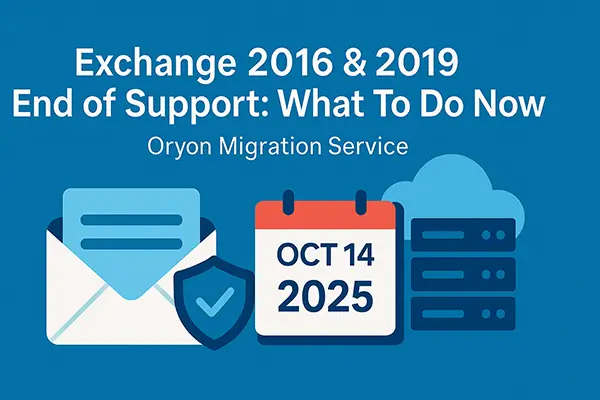TL;DR: If you’re still on Exchange 2016/2019, you need a plan — either upgrade to Exchange SE or migrate to Microsoft 365, ideally with an experienced partner that can minimise risk and downtime.
On October 14, 2025, Microsoft ended support for Exchange Server 2016 and 2019. That means no more security patches, bug fixes, or standard technical support. Unsupported email servers quickly become compliance liabilities and prime targets for threat actors.
Microsoft’s Exchange Server Subscription Edition (SE) is now available and will be the only supported on-premises Exchange going forward. It aligns to a “stay current” model and is designed as an in-place upgrade for supported Exchange 2019 builds.
Your options (and when to choose each)
1) Move to Exchange Online (Microsoft 365)
Best for: most organisations that want stronger security, always-up-to-date features, and less infrastructure to manage.
Why: Microsoft 365 receives continuous security updates and integrates natively with Teams, Purview, and Copilot.
2) Upgrade to Exchange SE
Best for: organisations that must retain on-prem mailboxes for data sovereignty, regulatory, or specific integration needs.
What changes: subscription licensing, modern lifecycle (“stay current”), in-place upgrade from Exchange 2019 CU15+, and feature parity at initial release with a focus on lifecycle/support first.
3) Hybrid (phased migration)
Best for: large or complex environments that need staged moves, coexistence, or temporary on-prem routing/control during transition.
Note: Microsoft has provided guidance and (time-limited) Extended Security Updates (ESU) to help laggards complete transitions safely, but ESU is a temporary stopgap, not a long-term strategy.
Risks of doing nothing
- Security exposure: newly discovered vulnerabilities won’t be patched in standard support.
- Compliance gaps: many frameworks require supported software and timely updates.
- Operational risk: no mainstream bug fixes or CU updates; higher likelihood of outages and incompatibilities as adjacent systems evolve.
A pragmatic 30-day migration playbook
Week 1 — Assess & prepare
- Inventory mailboxes, archives, public folders; map item counts and sizes.
- Identify shared/delegate access, transport rules, connectors, and SMTP relays.
- Triage “blockers” (legacy protocols, third-party journaling, EWS apps).
Week 2 — Clean up & pilot
- De-provision stale accounts, archive or delete dormant mailboxes.
- Pilot a representative user group (VIPs excluded at first) to validate throughput, identity, and coexistence.
- Baseline user communications and FAQs.
Week 3 — Scale
- Run staged (pre-cutover) syncs to shrink the final window.
- Validate permissions/auto-mapping, shared mailboxes, and distribution groups.
- Prepare DNS cutover steps and rollback plans.
Week 4 — Cutover & hardening
- Execute final delta sync; switch MX, Autodiscover, and related DNS.
- Verify mail flow, calendars, mobile profiles, and client re-autodiscovery.
- Apply post-migration security baselines (MFA/Conditional Access), data loss prevention, and retention.
How Oryon Migration Service de-risks the journey
- Architected for your path: Microsoft 365 cloud, Exchange SE upgrade, or hybrid coexistence—we design what fits your compliance, sovereignty, and cost constraints.
- Low-downtime execution: pre-stage syncs and delta runs to keep the cutover window tight.
- Identity done right: Entra ID design, Conditional Access, MFA enforcement, and hybrid best practices to close common attack paths.
- Permissions & coexistence care: shared mailboxes, delegates, send-as/send-on-behalf, transport rules, and connectors preserved/validated.
- Operational visibility: progress dashboards, exception handling, and clear stakeholder comms.
- Security & compliance hardening: post-cutover baselines for threat protection and data governance mapped to your framework.
Frequently asked questions
Is Exchange 2016/2019 really out of support?
Yes. Microsoft’s end of support date for both products was October 14, 2025.
What if we can’t finish by the deadline?
Microsoft offers a limited Extended Security Updates (ESU) program to buy time, but it’s temporary and paid. Use it only to complete your upgrade/migration.
What is Exchange SE?
Exchange Subscription Edition replaces traditional perpetual on-prem versions. Initial release is feature-parity with Exchange 2019 CU15, with a modern “stay current” lifecycle and an in-place upgrade path.
Is hybrid still viable?
Yes—especially for phased moves and complex integrations. Plan to keep SE current if you retain on-prem roles.
Ready to move? Here’s a smart next step
Book a readiness assessment with Oryon Migration Service. You’ll get:
- A risk & readiness report (security, compliance, and identity).
- A migration or SE-upgrade blueprint with timelines and cost estimates.
- A communications kit for end-users and IT stakeholders.
References
Microsoft lifecycle and product team guidance on Exchange end of support, Exchange SE, and ESU were used to inform this article. See Microsoft’s announcements and docs for details.


